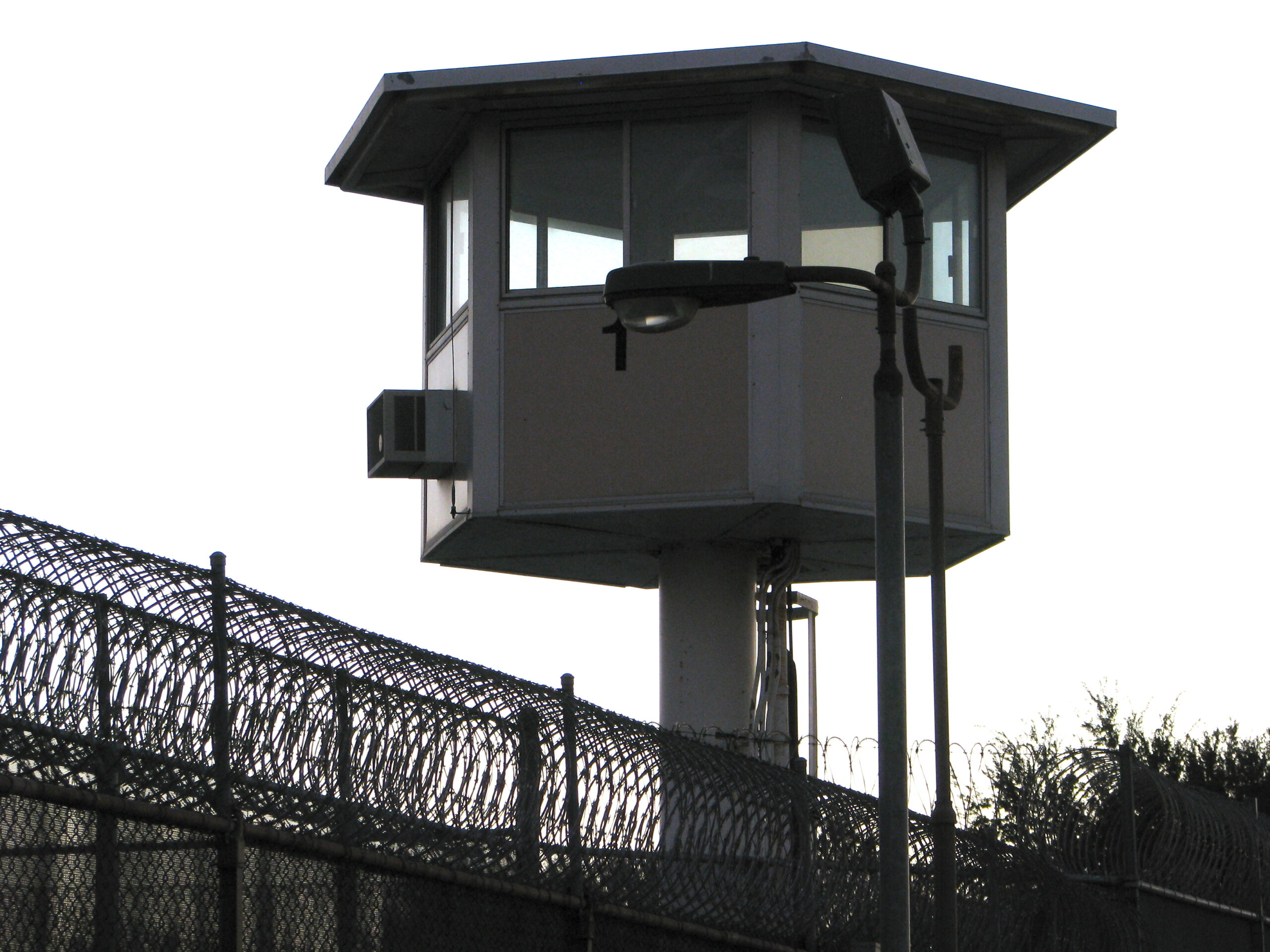Shielded from public view, “correction officers” received scant discipline, Shannon Heffernan reports.

(Rennett Stowe, CC BY 2.0, Wikimedia Commons)
By Shannon Heffernan
WBEZ and ProPublica
 Correctional officer James Fike already had been suspended twice when the Illinois Department of Corrections began investigating allegations that he had beaten a man who was incarcerated at Pontiac Correctional Center, in a small town in central Illinois, in 2016.
Correctional officer James Fike already had been suspended twice when the Illinois Department of Corrections began investigating allegations that he had beaten a man who was incarcerated at Pontiac Correctional Center, in a small town in central Illinois, in 2016.
The man, Jamale Douglas, was in trouble for holding open the slot in his cell door where staff deliver food trays. When Douglas refused to pull his arm out of the slot, staff said they called in a special tactical team to remove him from his cell.
According to a report from Department of Corrections’ internal affairs officials, who investigate both staff and prisoner wrongdoing, Douglas refused to get in handcuffs, so officers maced him.
Douglas said the tactical team then came into his cell and he was repeatedly punched, even after he was handcuffed.
Staff are required to film the situation anytime the tactical team forcibly removes someone from a cell, and the video of this incident, as described in that report, shows an officer making an “up and down” motion with his arm in the back of the cell. That video is incomplete — an officer in charge of videotaping explained the gap by saying it occurred when she was changing the camera battery. Later video footage shows Douglas’s face covered in blood, and photos from the prison show that his face was swollen and bruised and that he appeared to have a chipped tooth.
When internal affairs investigated, another employee identified the officer in the video as Fike, who had already been suspended in 2014 for reasons that are not public, and again in 2015 for violations of “standards of conduct.”
This time around, Fike told investigators that he wasn’t sure if it was him and that “he did not recall losing control” and that he had “kept it professional.”
But the prison investigators ruled that accusations of excessive force were substantiated based on the testimony of other officers and on the video. Fike received a written reprimand, which was then expunged from his record by the warden, according to documents from internal affairs — though no explanation for the expungement is given.
What was remarkable about these cases was not the findings, however, but what happened next. Two years later, in 2018, Fike was promoted to lieutenant. How could a correctional officer disciplined three times in three years be promoted? WBEZ and ProPublica tried to find out.
Calls for Consequences

Illinois state capitol building in Springfield, 2017. (Adam Jones, CC BY-SA 2.0, Wikimedia Commons)
Across the country, there have been calls for increased consequences for police officers who harm people. In Illinois, the state legislature passed a massive criminal justice bill in 2021 that gives the state more power to decertify problematic police and remove them from duty.
But those reforms have had no effect on how correctional officers are disciplined. That system is so shielded from the public that experts say it is difficult to track if the Department of Corrections is properly handling misconduct allegations.
Here’s why: Disciplinary records for an individual correctional officer are exempt from public disclosure if the documents date back more than four years. And the reasoning and evidence that went into the disciplinary decisions are invisible because publicly available records show only the outcome, nothing about the decision-making process.
So WBEZ and ProPublica used the files that are available to try to piece together how the system responds when internal investigations find that staff engaged in serious misconduct against prisoners. The news organizations reviewed hundreds of pages of internal affairs documents detailing when a corrections employee was found to have done something wrong.
Through that effort, WBEZ and ProPublica identified 18 Illinois corrections employees who, according to internal affairs findings between 2014 and 2019, had misused force or sexually harrased people incarcerated in the state’s prisons, but who remained on staff. In one case, an imprisoned man died from asphyxiation when guards restrained him. In another case, a video shows a guard pulled a man from his prison bunk and pushed him against a wall; according to the man, the officer then choked him until he nearly passed out.
Of those 18 employees whom internal affairs found responsible for serious wrongdoing, all 18 held onto their jobs after the misconduct; 11 remain employed by the Illinois Department of Corrections today; the others either retired, resigned or were terminated years later, for apparently separate reasons. For seven of the 18, no discipline was recorded in the personnel records that were available via public records laws, although after a period of time disciplinary records may be shielded from public disclosure. We did find that at least eight of the 18 were suspended shortly after the misconduct and at least four, including one who was also suspended, were fired — and then later reinstated after they filed grievances.
The Department of Corrections claims that state laws requiring records to be made public apply only to the final outcome of the case, not to any documents from discipline hearings in the Department of Corrections or to hearings about whether to reverse penalties. Even the records of discipline are exempt from public disclosure after four years.
When asked about transparency regarding staff discipline, Anders Lindall, a spokesperson for AFSCME, the union that represents most corrections staff, shared portions of the state’s transparency statute that mention concerns over privacy and security, but did not elaborate.
Advocates say the Department of Corrections needs to provide increased transparency, especially given the life-and-death circumstances of its work.
“We should know exactly what it is they’re doing, how they’re being disciplined, all of the information around that should be made publicly available,” said Jenny Vollen-Katz, executive director of the John Howard Association, an independent citizen group that has monitored Illinois prisons for more than a century. “We cannot hold accountable behavior that we can’t see happen.”
That secrecy contrasts with the Chicago Police Department, where evidentiary hearings about the most serious cases of alleged misconduct are open to the public and evidence — including dispatch recordings, body camera video and police reports — is posted online.

Hearings about the most serious cases of alleged misconduct against Chicago police are open to the public and evidence is posted online. (Daniel Schwen. CC BY-SA 4.0, Wikimedia Commons)
The call for changes in correctional officer discipline comes amid criminal proceedings of three guards charged in the 2018 death of Larry Earvin while he was incarcerated at Western Illinois Correctional Center. Documents reveal there had been a pattern of abuse, sometimes involving the same officers and the same location in the prison, prior to Earvin’s death. One officer pleaded guilty, another was convicted at trial this year and a third is scheduled to go on trial in July.
The Illinois Department of Corrections did not respond to repeated requests for an interview and did not answer numerous written questions. But in a written statement, prison officials said that the department takes appropriate disciplinary action when an employee violates rules and that “employees facing possible discipline must be provided due process rights under their union contract and the personnel rules.”
WBEZ and ProPublica also sought comment from all 18 staff members, as well as their union, about the wrongdoing that internal affairs found they had committed, and all either declined comment on the specific cases or could not be reached despite multiple attempts.
Sarah Grady, a civil rights attorney with Kaplan & Grady who has spent over eight years working on prisoners’ rights cases, said the public needs to know about “folks who are misusing the great power that they’ve been given as correctional staff.” As long as it remains secret, she added, “there’s really no disincentive to continuing to commit that abuse.”
‘They Do It Just Because They Can’
In 2019, the Department of Corrections’ internal affairs division conducted an investigation into Jason Hermeyer and Christopher Melvin, two staff members who ran a program where incarcerated men worked making eyeglasses. Investigators conducted more than a dozen interviews with department employees and prisoners, which revealed a pattern of prisoner abuse.
According to one witness cited in the report, Hermeyer would put his leg up on a table, “like the Captain Morgan statue,” and gyrate toward prisoners. Incarcerated men and at least one staff member also reported that he would grab men’s rear ends and grind his genitals against them. Witnesses said the sexual harassment was so common that men placed mirrors at their workstations so they could see Hermeyer approach.
Both staff members treated the imprisoned men in a range of cruel or unprofessional ways, according to an internal affairs report. On one occasion, prisoners said staff ordered a man to get into a cardboard box and taped it shut. Then, according to one witness, Melvin had other incarcerated men dump the box in a trash can. At other times, the report says, men were forced to make decorations for a graduation party for Hermeyer’s and Melvin’s kids and to make eyeglasses for Melvin’s relatives.
Hermeyer and Melvin denied the allegations, according to department reports but internal affairs investigators found that the evidence substantiated multiple accusations against the two, including allegations of unauthorized use of state property, sexual harassment and, in Hermeyer’s case, sexual assault. Both were also criminally charged for official misconduct, a felony, although the state’s attorney ultimately dropped those charges as part of a diversion program agreement that required them to do things like community service.
Today, Hermeyer still works for the Illinois Department of Corrections, while Melvin retired in 2021, two years after the internal affairs report.
Richard Serrano says he experienced abuse and harassment under Hermeyer and Melvin while incarcerated. “They do it just because they can do it,” Serrano said in an interview. “They can get away with it.” Neither the lawyer nor the union representing Hermeyer and Melvin responded to a request for comment about the internal affairs investigation or criminal charges; the Department of Corrections also declined to comment.
WBEZ and ProPublica set out to learn what happened next, both in the Hermeyer and Melvin cases and in the 16 other cases we identified where a correctional officer was found to have violated use-of-force rules.
The news organizations searched the public record for evidence of any discipline that was meted out. We requested information from personnel records and from the state office that handles grievances from employees facing discipline. We found that even in an extreme case in which internal affairs concluded excessive force had caused a death, there was no public information on whether or how the officer was disciplined for that death.
“Even in an extreme case in which internal affairs concluded excessive force had caused a death, there was no public information on whether or how the officer was disciplined for that death.”
The news organizations found that internal affairs ruled that charges had been substantiated against four Pontiac guards who, in a 2015 incident, continued to apply force to a man named Terrance Jenkins even after he was restrained, face down, and no longer posing a threat. A pathologist concluded Jenkins died from asphyxiation. In 2018, the state settled a $2 million lawsuit linked to the incident, but even after the internal affairs findings and settlement, the guards kept their jobs, according to state records.
For Hermeyer, the corrections employee who was found to have sexually harassed men in prison, a public records request early in the reporting process revealed that he had been suspended without pay for 21 days. But for Melvin, it took months to find out what happened. Ultimately, the department did disclose that Melvin received a 15-day suspension.
One key way corrections employees are able to keep their jobs and avoid punishment is by filing grievances through the union; some of those end up in arbitration. But those processes, too, happen behind closed doors.
The grievance system came into play in a 2016 incident involving Demarko Mason, who was incarcerated at Stateville Correctional Center. Mason said he was in his bunk when an officer named Adrian Thomas began yelling at prisoners who were supposed to be in their beds.
In an interview with WBEZ and ProPublica, Mason said that when he laughed, Thomas came charging at him “like a raging bull.” An internal affairs report says Thomas yanked Mason off the top bunk, causing him to hit his head on another bunk. Thomas then pushed him against the wall. Most of the incident was caught on video. Mason said he was choked until he nearly passed out, but the camera angle does not clearly capture the part of the incident in which he says he was choked.

Stateville Correctional Center in Illinois. (Rw2 at English Wikipedia, CC BY-SA 3.0)
In an interview with internal affairs, Thomas said that besides “helping Mason off the bed,” he never touched the prisoner. Internal affairs said Thomas had violated departmental rules regarding use of force. The department fired him. But that’s when the union proceedings kicked in: Thomas filed a grievance and then, after he’d been away from the job for more than a year, the department reinstated him. The basis for that decision has not been released. Thomas continues to work for the department and declined to comment for this story.
Neither the union nor the Department of Corrections provided data for how often disciplinary decisions were overturned. But state employment records show that of the 141 staffers discharged for cause from May 2016 to May 2019, 33 were reinstated.
Before he retired in 2004, Charles Hinsley worked for the Department of Corrections for 20 years and served as a warden at Menard Correctional Center. He said the way grievances and arbitration worked made it difficult for him to hold staff accountable. (AFSCME, the union that represents most correctional officers, says the grievance system provides an important check, ensuring that discipline is fair.)
While he was warden, he was accused of being too pro-prisoner and anti-staff, and the union cast a vote of no confidence against him. But, he said, when administrators fail to respond to staff violence, it puts both incarcerated people and other staff at risk.
Hinsley said that inaction in response to staff misconduct sends a message to the incarcerated that “we have to fend for ourselves.” He added, “My position is always if there’s an employee that has been found in violation of staff misconduct, and it’s a very grievous level of misconduct, and they were terminated, they shouldn’t ever be reinstated.”
New Legislation
WBEZ and ProPublica asked the Illinois Department of Corrections about the opaque disciplinary records. A spokesperson said the department doesn’t track data that would show how often it disciplined employees.
Vollen-Katz said knowing how staff misconduct and abuse is handled is essential to the John Howard Association’s ability to do its job as a watchdog group. “It’s outrageous, it’s irresponsible, frankly, for the state of Illinois that we don’t know that piece of information,” Vollen-Katz said.
Alan Mills, an Illinois civil rights lawyer and executive director of the Uptown People’s Law Center, said other places, like Oregon, already publish information about correctional officer misconduct and Illinois should move in that direction.
In February of 2021, Illinois Gov. J.B. Pritzker signed a massive criminal justice bill that, among other things, mandates an annual report to the legislature outlining the number of investigations conducted into state police misconduct and their outcomes. After the bill’s passage, its sponsor, state Sen. Elgie Sims, said those provisions do not apply to corrections officers, but he is aware of how important it is to address the behavior of prison staff.
Sims said the new law “should only be a starting point in an ongoing effort at reform.”

Illinois Gov. J. B. Pritzker in 2019. (Raymond Cunningham, CC BY-SA 2.0, Wikimedia Commons)
Those reforms could include independent oversight, a strategy the John Howard Association has spent years pushing for. To make that kind of system effective, advocates say, any oversight body would need autonomy, enforcement capabilities and the power to share information with the public.
Other states, like New Jersey and Washington, already have a corrections ombudsperson, an independent office that can rule on disputes within the department of corrections. A bill that would create an ombudsperson for the Illinois Department of Corrections was proposed in 2021 but has not become law.
Shareese Pryor, who was the chief of the Civil Rights Bureau of the Office of the Illinois Attorney General and now works as senior staff counsel for Business and Professional People for the Public Interest, told the news organizations there needs to be more transparency into accusations of and discipline for correctional officer misconduct “so that the public knows what’s happening and whether public actors are responding to brutality within our jails and prisons.”
Such measures might have helped in the case of Fike, the correctional officer who was suspended twice and given a written reprimand for excessive force before he was promoted to lieutenant in 2018. The story didn’t end there: The next year, he was criminally charged with battery and official misconduct for another prison beating. That time, Fike pleaded guilty to battery, and a felony charge of misconduct was dropped. He resigned from the department in June of 2019.
Shannon Heffernan is a criminal justice reporter with WBEZ Chicago.
—Claire Perlman contributed research.
This story was originally published by ProPublica, a Pulitzer Prize-winning investigative newsroom. Sign up for The Big Story newsletter to receive stories like this one in your inbox.

Just another “Sh*thole Country” …
The best reform would be abolition. The vast majority of prisoners don’t need to be locked up. End the drug war, legalize drugs and expunge all convictions for drug-related offenses. Stop incarcerating people for non-violent crimes like theft. And most of all, end the conditions that create violent offenders like poverty, lack of healthcare and substandard housing/education. If we would spend what we spend on police and prisons on helping people in the first place, we’d barely need police and prisons, if at all.
But, yes, now that we’ve gotten to this point, we need to reform the system for how guards are disciplined and make it more transparent.
The exceptional, wealthy, civilized Christian nation is an unbelievable brutal nation, civilized it is not. People believe that brutal punishment is the only way to deal with crime and violence, the government must be more violent.